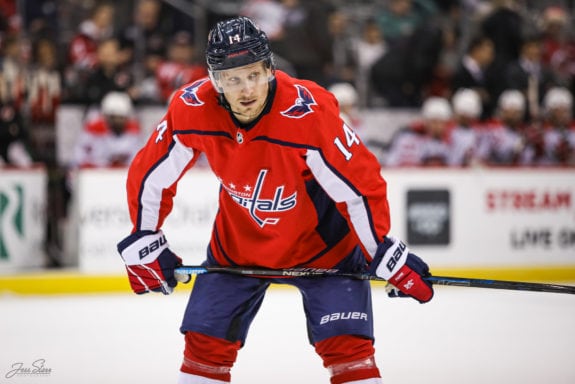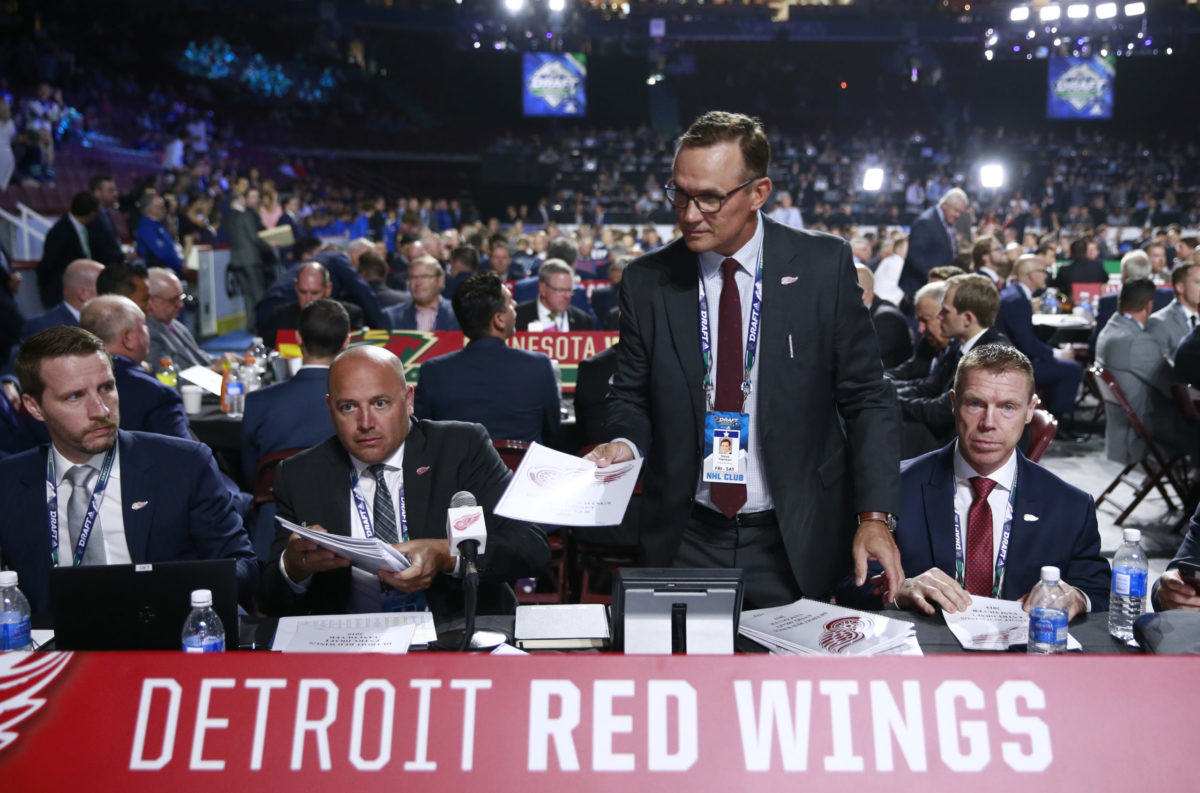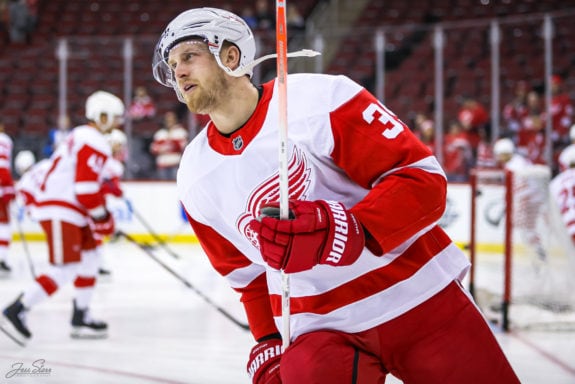Since Anthony Mantha got off to a slow start this season, Red Wings fans have wondered whether or not this would be his last season in Detroit. Well, those fans got their answer ahead of the trade deadline as it was announced that the Red Wings had traded him to the Washington Capitals in a deal that yielded forwards Jakub Vrana and Richard Panik, along with a 2021 first round pick and a 2022 second round pick.
There’s a lot to digest here from the Red Wings side of things, so let’s dive right in:
So Long, Mr. Mantha
Selected with the 20th pick of the 2013 draft, Mantha has played within the Red Wings’ organization since 2014 when he joined the Grand Rapids Griffins of the AHL. His skill was undeniable during his two seasons with the Griffins as he collected 44 goals and 88 points through 132 games. After a 10-game stint with the Griffins to start the 2016-17 season, he made the jump to the NHL and never looked back.
With the Red Wings, Mantha put up 194 points through 302 games, a points per-game rate (P/G) of .64. His underlying numbers always suggested that he was the Red Wings’ top player in terms of pure offense and impact on the play, but those analytics were too often muted by his sometime lackadaisical play, especially in his own zone. While he was a force to be reckoned with when he was on his game, you would see him float around on the ice when he was off his game, not really engaged into what was going on around him.
The Capitals are betting big that Mantha can be the player he flashed in Detroit on a more regular basis. To their credit, if that proves to be true, Washington will have boosted their top six in a big way; he has never had the kind of playmakers and finishers that the Capitals lineup features. Playing alongside Evgeny Kuznetsov or Nicklas Backstrom should do wonders for his goal scoring numbers. While Mantha is a player that is worth a proverbial “second chance”, I’m here to tell you that the cost of that “second chance” is heavily skewed towards the Red Wings.
Yzerman Didn’t Panik
First off, let’s look at Panik, who I think is the least-valuable piece of this puzzle.

That’s no knock on him either, as Panik could very well prove to be a solid piece for the Red Wings. At 30-years-old, he is a veteran of just over 500 regular season games in the NHL, including stints with the Capitals, the Arizona Coyotes, the Chicago Blackhawks, the Toronto Maple Leafs and the team that drafted him, the Tampa Bay Lightning. No matter where he has played, he has almost always been a third-line, abrasive player that isn’t afraid to be “that guy” on the ice. While he’s no Darren McCarty, or even Givani Smith for that matter, he is somebody that can chip in offensively while also getting under the skin of Detroit’s opponents.
“(Panik) can play a variety of roles for us,” general manager Steve Yzerman said during his trade deadline press availability. “We want to surround (the core group of players) with players that help them grow and develop.”
Yes, he is a bit over-compensated at $2.75 million for two more seasons beyond this one, but with the overall financial flexibility the Red Wings are poised to have starting this offseason, his cap hit is just a drop in the bucket in the grand scheme of things. Detroit could look to retain half of his cap hit in a future trade as well, making him a bit more appealing for what he offers. Lastly, he also gives the Red Wings somebody with a contract to expose to the Seattle Kraken in the upcoming expansion draft. Don’t overlook that fact.
Vrana is a Quality Player
You could make the argument that Mantha and Vrana are actually very similar in terms of production. To that point, Yzerman repeated multiple times that he and the Red Wings “feel we got a replacement for (Mantha).”
For his career, spent entirely with the Capitals, Vrana has a P/G of .55. He was the 13th pick of 2014 draft – picked just two spots ahead of Dylan Larkin – and he still has plenty of skill to offer in a top six role. While he mostly plays the left wing, he can shift over to the right side as well – he has a career shooting percentage of just over 13 percent, which is a full point ahead of Mantha’s career rate. For a player that was reportedly disgruntled with his usage in Washington, Vrana should get plenty of opportunity to put his full skillset on display in Detroit.
At just 25 years old, Vrana is in his prime and has plenty to prove after an uneven career in Washinton. After posting a career-high 52 points through 69 games last season, he “slumped” to just 25 points through 39 games so far this season. He has never averaged above 15 minutes of ice time through five seasons in the NHL, a fact that could and should change with Detroit.
“We look for (Vrana) to play a bigger role (in Detroit),” Yzerman said when elaborating on the acquisition of Vrana. He said while the organization is happy to accumulate draft picks, “we also need to put a team on the ice,” and he believes that this player is one that will help maintain the competitive hockey Detroit has been playing this season.
Vrana’s career Corsi-for% is 51 percent, which is slightly below Mantha’s career mark of 53 percent. While Mantha’s high-end is likely higher than Vrana’s, they’re not too dissimilar; swapping these two likely amounts to only a slight downgrade for the Red Wings. Where you might see some eerie similarities between these two players, though, is their engagement throughout a given game. The newest Red Wing was recently made a healthy scratch by Capitals head coach Peter Laviolette for his lack of effort on the ice.
“We’re looking for a higher level of play,” Laviolette said at the time. “(We hope to) reignite a fire inside of his game.”
Sound familiar?
Picks!
With the addition of the Capitals’ first round pick in 2021, the Red Wings now hold seven picks through the first three rounds of this year’s draft. All-in-all, they should hold eight of the first 100 picks in the draft, which should lead to another healthy injection of young talent into their prospect pool. It’s not just about the quantity of picks they have though; no, their sheer amount of quality picks is going to give the Red Wings’ rebuild a significant boost.

With the likes of Moritz Seider and potentially others joining the Red Wings’ roster next season, the additional first round pick gives Yzerman and his scouts a chance to immediately replenish the prospect pool with two more top-end talents. In order to sustain success like the Tampa Bay Lightning have done, the Red Wings need to establish a constant stream of quality prospects that can join the team and make a difference. The picks acquired in this deal should go a long way towards establishing that stream.
As for the 2022 draft, the Red Wings now hold additional picks in both the second and fourth rounds. The 2022 draft is expected to be deeper than the 2021 class, and adding a second round pick, even if it falls outside of the top 50, should net Detroit another quality prospect, or at least one with raw skills that just needs time to develop. Whenever a rebuilding team can add two premium picks to their collection, that’s a good thing. The Red Wings’ timeline for their rebuild could very well get adjusted after these picks are made.
Future Considerations
This deal isn’t just about 2021 and 2022, though. While the Red Wings will see immediate returns from this deal in the form of Vrana and Panik finishing this season, as well as prospects added from this year’s draft, this is a deal that Detroit could reap benefits from heading into 2022 and 2023. When you have a GM like Yzerman at the helm that has made it clear that anybody can be had as long as the price is right, you can imagine how the Mantha trade tree can expand.

First off, while Panik is signed for another two years, he’s somebody that, should Detroit retain some salary as previously mentioned, could be sent off to a contender to provide some depth. He has 20 games of playoff experience, and could fit into the bottom six of a team looking to make a run – that’s what the Capitals brought him in for, the fit just never worked between the two parties. Suddenly, by bringing in Panik, Detroit has a player they can slot into their middle six, and then flip for another draft asset down the road.
As for Vrana, the first step is to see whether or not there’s a long-term fit between this player and the Red Wings. Let’s not forget: Mantha was signed to a four-year deal back in November. The original intention must have been for him to be a part of the Red Wings for the foreseeable future. Now, it’s Vrana who has the opportunity to seize a spot in the Red Wings’ future plans.
If a fit never materializes, however, the Red Wings are not beholden to this player. Just like they did with Mantha, they could sign Vrana to a new deal this summer (he’s a pending restricted free agent, so they will have to), experiment with his long-term fit with the Red Wings by putting him in a spot to have success, and then trade him for additional assets should the fit not work. One of the “worst” outcomes of this trade is that the Red Wings end up with more picks than just the two they originally received from the Capitals. Honestly, that doesn’t sound too bad to me.
Moving Forward
This is a trade that dramatically changes the look of the Red Wings’ offense. For the last couple years, Mantha has been the de facto number two guy behind Dylan Larkin. With the big power forward now off to Washington, there is a huge opportunity up for grabs.
Filip Zadina is now the Red Wings’ most skilled winger, and he’s still developing at just 21 years of age. He should take a big step forward with Mantha not there to take some of the attention away from opposing defenders. Vrana can step into that role as well, and that may be the best possible outcome of this trade. A potential line of Larkin between Zadina and Vrana could be as dangerous a line as the Red Wings have had in some time.
The most encouraging thing to come out of this trade might have come during Yzerman’s press availability, however. When talking about the impact of this trade and whether or not it might have made sense to hold on to Mantha and trade him further down the road, the Red Wings GM noted that in “three or four years, we hope to be a better team by then.” If you’re looking for a timeline as to when to expect the Red Wings to take a meaningful step forward in terms of competing in the NHL, that very well might be it.
With the assets acquired in this deal, that timeline doesn’t seem that far-fetched.
Want more Red Wings content? Tune into The Hockey Writers’ Grind Line — a weekly show on YouTube and Facebook. Check out our most recent show below, and make sure you subscribe to the channel so you don’t miss any upcoming shows.